
Return to
Home Page
Link to Our Advertisers

Return to EBM
Corporate Home Page
Contact Information Subscribe Archives EBM HOME


Highlights
of the JULY/AUGUST 2007 issue:
NEWS BRIEFS:
NACS
A public hearing to discuss recommendations made by the Advisory Committee on Student Financial Assistance (ACSFA) in a recently released report on textbook costs included testimony from the National Association of College Stores. Speaking for NACS was the association's elected president William Simpson, who is also president and general manager of the UConn Co-op at the University of Connecticut. Also testifying were several other college store representatives.
NACS supports steps to ensure a healthy used book supply, but is cautious of the reports focus on digital solutions as a “silver bullet” in the long term. “While this concept is one possible solution, I think it might be best to allow the marketplace to determine what makes more sense for individual institutions and consumers, including smaller colleges or students who might have less computer access,” Simpson said. THOMSON LEARNING SOLDThomson Corporation signed an agreement in May to sell the higher edcuation, careers and library reference assets of Thomson Learning to funds advised by Apax Partners and OMERS Capital Partners. The transaction is expected to close in the third quarter of this year and is subject to regulatory approval. Also, a consortiumof funds advised by OMERS and Apax will acquire Nelson Canada, which provides books and online resources for education in Canada. CAMEXCAMEX, for the fifth consecutive year, is ranked among the top 200 trade shows by Tradeshow Week Magazine, a journal of the trade show industry. Produced by the National Association of College Stores, CAMEX combines a three-day trade show featuring more than 30 merchandise categories targeting 18- to 24-year-olds with two days of educational programing. “The ranking of our 2006 CAMEX in the 2007 Tradeshow Week survey was 189, one place higher than the prior year and three higher than the one before that,” said Hugh Easley, NACS vice president of meetings and expositions. “Further rankings should continue to climb, since our most recently concluded trade show, CAMEX 2007, was the largest in nine years, and we had an exhibitor waiting list of more than 100 companies.” STAEDTLERStaedtler Inc. promoted Kurt Kirkland to director of operations and purchasing. He is responsible for managing Staedtler's logistics facilities in Ontario, Calif., and Dover, N.J., as well as product inventory levels and purchasing and inventory control personnel. NEWS & TRENDS:
HIGHER ED IS COOL TO SENATE TEXTBOOK BILL
The battle to tame textbook-price inflation that led nearly two-dozen state legislatures into action has spread to Washington, D.C., where a bill defending affordable course materials is before the Senate. Senate Bill 945, the College Textbook Affordability Act of 2007, seeks to provide better, timely access to course materials for students without interfering with faculty choice or imposing information sharing on publishers and bookstores. The legislation anticipates that faculty, when well informed by publishers of pricing and options available for course materials, will adopt lower-cost alternatives. Toward this end, the bill associates retail pricing information for specific course materials adopted by faculty with course schedules, allowing students to consider cost when choosing classes.
It is the institutional requirements that most concern higher education. Faculty usually finalize adoptions for the coming academic term weeks or months after students have completed course schedules, resulting in inaccurate pricing information. There is also reluctance to sharing course list, enrollment and adoption information with retailers. Introduced March 20, 2007, the bill is sponsored by Sen. Richard Durbin, D-Ill., co-sponsored by Sen. Norm Coleman, R-Minn., has been read twice and referred to the Committee on Health, Education, Labor and Pensions. It applies to all institutions that accept federal aid, whether public or private. NACS generally supports the publisher requirements set in section 4, but is concerned with timing problems raised by requirements outlined in sections five and six. Publishers often change ISBNs and pricing can be revised two to three times a year, resulting in any information put out to faculty and students early in the process becoming obsolete and confusing. Bookstores are also concerned that requiring institutions to provide course list information to retailers would subsidize competitors, particularly online sellers as well as interfere with existing state freedom of information laws, which regulate how details, such as book adoptions, are made available to local retailers.
FIRST-TIME AND VETERAN VENDORS GIVE COLLEGE STORES CHOICES
Whether a vendor attends CAMEX for the first time or is a returning veteran with years of experience in the college market, the three-day-long exhibit floor is a once-a-year opportunity to reach as many bookstores as possible with merchandise or services that can make the store more compelling to customers.  Many factors influence the opinion customers have of a store. After the requisite school supplies, there are the discretionary items customers buy on impulse and that express the campus personality, such as high-quality paper for printing reports or resumes, greeting cards and entertainment on CDs/DVDs. Then there is the category of expressive, novel items perfectly suited to college-age students from flip-flops that add an innovative decorative dimension to sandal-style footwear and baseball caps with a bottle opener built into the bill to emblematic gift items and environmentally friendly bags. Of course, getting customers to shop the store requires building awareness, and solutions to that range from shopping bags printed with Web address or other information and efficient traffic flow to customer service conveniences accessible online. STAPLESOn the core merchandise side of college store inventory, Staples Inc. began a partnership with bookstores in 2006 that grew from a New Opportunities committee comprising the participation of college stores and the National Association of College Stores. One of the committee's goals to build and improve on an earlier program involving Office Depot. “There were a lot of lessons learned from that,” said Jason Rome, executive director, new retail channels, at Staples.
In designing the program, Rome said one goal was for stores to participate while retaining their independence to set and maintain profit margins. He also wanted college stores to share in and benefit from Staples' marketing expertise, statistical analysis, return capabilities and convenient in-store kiosks. The kiosks link to Staples.com, where, Rome said, customer can order from a selection of up to 28,000 stock keeping units and pay in the store, which gives bookstores the opportunity to expand into categories without physical inventory. A key difference is this program recognizes the unique characteristics of college stores compared with Staples and similar office supply retailers. “You'll find items in this channel that are different from what you find in our retail stores,” said Frank Farias, director of The University of Arizona BookStores. College students shopping college stores prefer different package sizes and merchandise compared with the business customers buying at Staples or similar office supply stores, Farias explained. With engineering paper, for example, Staples has certain types and can get others for college stores, he continued.
University of Arizona was a bookstore on the committee, and influenced the program to reflect community causes, such as breast cancer awareness, boys and girls clubs and environmental protection programs. Bookstores are in the supplies business and an advantage was seen in selling merchandise with a connection to social programs involving the University of Arizona. “That was a significant part for us, to have a partner in this area,” Rome said. Another thought was for Staples to be among the brands represented in the store, rather than have an exclusive presence. “I did not want to have everything Staples,” Rome continued.
Farias also sees advantages in the support Staples gives to college stores, including planograms, marketing, promotions and financial analysis. Information can be useful to drive business and either expand categories or identify slow sellers to be reduced or eliminated, he said. Since becoming a participant in the program, Farias said supplies sales at The University of Arizona BookStore have increased in contrast to a decline industrywide, which he attributes to Staples' international resources. The BookStore, for example, sells backpacks, desk accessories and laptop bags made according to specifications it has set and asked Staples to source. As a result, Farias continued, the BookStore is able to feature a leather backpack that is inexpensively priced, and any of this Staples merchandise that goes unsold is returnable. At CAMEX in Orlando, Rome said five stores were participating in the program, but having a booth on the exhibit floor was a recruitment opportunity since plans were to have more join by the start of the coming academic year this fall. “We're expanding the program in 2007,” Rome said. NEENAH PAPERDesigner supplies is a growing segment, and Neenah Paper Inc. was a first-time exhibitor at CAMEX this year with premium paper for printing reports, resumes, etc. that sees the college market as a natural next step. Neenah Paper is a North American-based premium paper mill that founded in 1873 and sells to the business market, such as commercial printers and graphic designers. Many colleges have their official watermark on Neenah paper, but the company did not have an established line of retail paper. As a result, Neenah decided enter retail and introduce to the college market small-pack counts, such as 100-sheet letterhead and 25-count envelopes, explained Patrick Lynch, senior business development manager for Neenah Paper.
The paper is higher-priced compared with standard copy paper and comes in 25 percent and 100 cotton bond as well as non-cotton. Retail prices of letterhead are $9.99 for 100 sheets and $19.99 for 500 sheets, for example, Lynch noted. Business cards and pocket folders are also part of the assortment. “We're all about helping business to communicate,” Lynch said. An environmentally friendly green line is 100 percent recycled, FSC certified and uses renewable energy credit received through Wisconsin Power, Lynch continued, noting that corporations choose to print annual reports on the paper. “Its everything you want in environmentally friendly paper.” Response to the green paper from stores at CAMEX has been good. “So far at the show, it's been the most popular paper,” he explained. “The student market fit our brands very well.”
Breast Cancer Awareness is a line paper featuring the a pink-shaded watermark of the breast cancer ribbon symbol, and 10 percent of sales goes to the Susan G. Komen Foundation for breast cancer research. Lynch noted that October is Breast Cancer Awareness month, and Neenah sees retail interest in supporting the cause. HALLMARK CARDSGreeting cards give college students a reason to shop the bookstore to commemorate birthdays, holidays or other significant moments in the life of friends and relatives. “A lot of faculty, staff and collegiate consumers likes a little bit of a fun type card,” said Rachel McClendon, a Hallmark Cards Inc. sales representative. “it's just a balancing act making sure everyone's happy.” 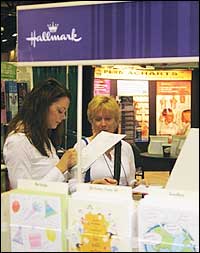
Bookstores have to juggle many types of customers. Hallmark usually talks with stores to get a better idea of a successful assortment. “We just try to get a good mix that's going to appeal to the wide variety of shoppers your store has,” McClendon continued. Hallmark knows the important questions to ask to set up a department with the most effective quantity and assortment of cards, and even provides display fixtures, which ready for cards or assembled by a crew, she explained. Recognizing unique characteristics of a college store is something Hallmark is experienced with doing. It works with over 700 college stores, which feature displays that range from as small as 22 feet to as extensive as 122 feet or more, McClendon said, noting that what works depends on each store's size and needs. Once a card section is in place, assortments can be adjusted based on what sells. Every year, Hallmark reviews the card line with an eye toward what has been carried for a while and opportunities to update with what fits and sells better, she continued.
All Hallmark sales reps working the college bookstore market are dedicated to higher education rather than straddling multiple retail channels. ARROW DISTRIBUTINGMusic and Movies are integral to student life. Arrow Distributing features assorted CDs and DVDs in three different programs that range from an extensive, full-service department to smaller alternatives allowing stores to feature the category. Full-department CD/DVD is for any store that needs a department featuring assorted new releases along with old standbys. Such a section begins with 8 linear feet evenly split between 4 feet of CDs and 4 feet of DVDs, each containing from $225 to $250 worth of inventory.
An alternative is where stores can order themselves at a lower wholesale price because no services are included, such as replenishment and reticketing, where merchandise arrives with a retail price ticket and ready to scan. Each store is responsible to sell and maintain this inventory. A third option is a promotional cardboard display containing a small assortment where Arrow is responsible for sales, as the contents are 100 percent guaranteed and unsold merchandise is returnable. “We're not going to make up an assortment that doesn't sell,” Jaskiewicz said. “It is priced for stores that don't have enough space.” Promotional signing is available for all programs, and is free. A newsletter is also included. HOTFLOPSNovelty items are the lighter side of college store inventory. HOTFLOPS was a first-time exhibitor at CAMEX that drew attention with a line of flip-flop-style footwear distinguished by novelty decorations. HOTFLOPS originated with flip-flops decorated with grapes on the strap going over the top of the foot, then, Linda Spann, owner/CEO/president of HOTFLOPS, said her four children suggested putting balls on the flip-flops and more sports-themed ideas followed. “It was a family grown endeavor,” Spann said. “I thought, what a fabulous way to support your sports team.”
Not content to simply exhibit at CAMEX, Spann was determined to score higher recognition. Her strategy was for every registration packet to include tickets for a flip-flops giveaway, sponsoring an evening reception and a booth contest to win a trip to Hawaii. “The line for flip-flops was larger than the line drinks,” Spann said, noting that 1,500 pairs were given out. Spann dismissed NACS suggestion that HOTFLOPS enter the fashion show during the educational programming, asking: “How many people look at people's feet.” “I believe, in a show this size, you have to come out with a blast,” she said. “I found out CAMEX was the biggest college show a year.” For Spann, the promotion was an investment expected to pay itself off down the road. “From a new vendors standpoint, you need to put some bucks into it,” Spann said. “If you don't, you're a little, tiny nothing.” OPENERS PLUSHaving attended other retail shows, Openers Plus decided to attend CAMEX this year for the first time because of its connection with the college demographic. “We thought this would be a good first step for us,” said Rob Davey, general manager of Openers Plus, in Costa Mesa, Calif. “The end user, or customer, seems like the perfect customer for our product.” Openers Plus, founded in 1990, makes emblematic hats with metal bottle openers built into the bill. “It sort of borders with novelty,” Davey explained.
Based on the response of visitors to the Openers Plus CAMEX book, Davey said stores see an opportunity, but some have concerns related to alcohol and drinking not being politically correct while others recognize a potential strong seller. GLORIA DUCHIN INC.Gloria Duchin Inc. is a maker of corporate gifts that sees college stores as a perfect fit for its assortment of seasonal pins and clip-on-a-page bookmarks, which are all metal and made in the United States.
“We could do 100 pieces in pewter, they just have to pay a model fee,” Bigmann said, referring to mold. Models typically range in price from $500 to $1,000, and, once made, are owned by the bookstore. “We kind of had a little bit of everything,” but stores are mainly interested in general and emblematic items, she said. ENVIRO-TOTEEnviro-Tote started out 16 years ago selling plastic bags and realized the need for reusable bags. Its bags have many application in college stores, including packaging textbooks pre-ordered for pickup by students. 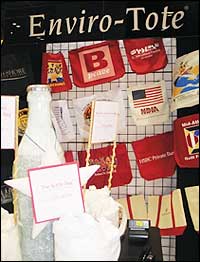
Enviro-Tote makes three types of bags: The Organic Cotton Bag, which is made of eco-grown organic cotton; The Bottle Bag, which is made entirely from 100 percent recycled soda and water bottles, and food containers; and The Recycled Cotton Bag, which is made of ECOTEC, a blended cotton yarn produced from excess fabric of newly-made clothing, plus 20 percent of this bag contains 100 percent recycled soda bottle material. Dying can be done on the organic bags but, Harvey said it diminishes the goal of being natural, and is being tried out on the recycled cotton bag. Enviro-Tote makes bags in different sizes, such as shopping and lunch. The bags can also be sold to students with the university or bookstore name printed on it or packaged for promotions, such as new students visiting campus, bagging textbooks on pickup, conferences at the institution or environmental clubs. Stores mostly buy Enviro-Tote bags for resale. “Textbook reservation seems to be really big this year,” said Sarah Harvey, sales representative for Enviro-Tote, adding that the bags are an incentive for customers to shop and buy online. “Its good for advertising.”
Stores also have the option of customizing bags by printing the e-mail address, logo, Web site or other information. REGAL POLY-PAKAttracting customers remains a college stores biggest challenge because, merchandise, no matter how well suited to the campus community, will not sell without reliable foot traffic.
Most campuses have more than one bookstore, which makes spreading word about and raising awareness of the bookstore increasingly influential to success. Hendry-Valaitis suggests stores feature at least the Web site address and a bold graphic, sometimes with a second color as a background, and maybe even the school mascot. “You want it to stand out,” she said. “The cute factor is always good, too.” Typical bag processes range from one color against a white background to images in multiple colors. BYU Idaho advertises its textbook reward program on its shopping bags. These bags featured student pictures and were produced in a four- or six-color process, she said. For the bags, Hendry-Valaitis said BYU spent an average of $200 for 100,000 bags, but stores can spend much more than that with expenses reaching into the thousands of dollars. Once the plate required to print the bags is created, Hendry-Valaitis said it can be reissued, which contributes to reducing the reorder price over time. She also suggests taking the same approach by using mailers as a marketing tool when fulfilling orders on purchases made by students or alumni through the bookstore Web site. LAVI INDUSTRIESInside the store, Lavi Industries manages customer flow by organizing and directing patrons into lines. It is targeting the bookstore market as a next step for growth after starting with admissions to arenas and stadiums. 
This was Lavi Industries' first year attending CAMEX. “I knew our product would work out for the college market,” said Dana Levy, national sales manager for Lavi Industries. Velvet ropes linked to posts can channel bookstore customers to merchandise or through checkout just as the cue line in airports, casinos and movie theaters. Lavi also aims to boost point-of-purchase sales because the ropes are designed for merchandise to be attached, which customers can see while waiting in line and add to what they are buying. For bookstores, for example, Lavi sees rush as a good application for its customer guide system. Bookstores could attach supplies, such as pens, to the line. “If they have long lines and they need to control their lines,” Lavi said. “This is just a much more organized way to do business.”
To enter the college store market, Lavi Industries working with any stores, but also has an agreement with College Store Design, the division of Nebraska Book Company. “We've partnered up with College Store Design,” Levy said. TOTAL COMPUTING SOLUTIONSCustomer experience increasingly is being shaped by convenient college stores are to shop at the click of a mouse instead of walking the aisles. Campus Webstore is a real-time interface from the Web to the back office that allows immediate updating to inventory or changes in the appearance of virtual storefronts. “We don't have to upload anything to the Web site,” said Fred Tuttle, president of Total Computing Solutions. Customers shopping a bookstore's Web site are looking right into its inventory database for all merchandise that retailers select to show online, including clothing, trade books and textbooks.
When students finish an order, Campus Webstore automatically writes the transaction to the Total Computing Solutions point of sale system for fulfillment and entering credit card information. On other systems this is entered manually, but Total Computing plans to make this automatic for other systems as well. Almost all forms of payment are accepted online, including in-store pick-up. Sell outs are automatically reflected on the Web site. Stores can set up provisions allowing customers to place orders for when inventory is restocked on items that can be replenished quickly, such as trade books and textbooks. Other merchandise, such as sweatshirts, may not be available again or might require stores to meet minimum quantities, which could extend reorder times. Faculty adoptions are online in real time, too. Professors can select the term, department, course and section, as well as look at previous adoptions to create new or updated selections instead of recreating the list each time the class is taught. Bookstores personnel can review faculty adoptions and approve the quantity of books being ordered is consistent with course enrollment as well as check whether new editions are coming out.
An advanced design mode of Campus Webstore includes capability for online buyback and e-mail blasts for notifying customers about specials and buyback or faculty of adoptions being due and information being available online. It also gives stores the ability to set up kiosks, which students can use to prepare pick lists by pulling up class schedules to see textbooks required according to multiple sorted formats, such as by department, book, section, author or title, and then get the books on shelves. The first Total Computing clients went live with Campus Webstore in the fall semester of 2006. By CAMEX in Orlando this year, Tuttle said four stores were using Campus Webstore version 1.5 and another four or five were ready to go live with it. Tuttle expects to release version 2.0 this fall. NEBRASKA BOOK COMPANYNebraska Book Company adds functionality with the release of WebPRISM 3.0 that simplifies how stores feature merchandise for sale online. For example, stores can identify a set of items that WebPRISM can randomly feature; or promotion of those items can be based solely on sales volume.
Another key feature allows bookstores to accept pre-orders of textbooks from students, even before adoption data is available. In WebPRISM 3.0, stores can transfer textbook information by department, course and section directly into the system. Once the books are confirmed for use, they are loaded onto the Web site for students to purchase. WebPRISM 3.0 also automatically updates both inventory and adoption information as changes are made to back office systems. All students need to do is provide the course, select the books needed, and WebPRISM 3.0 takes care of the rest.
Additionally, WebPRISM 3.0 provides functionality for coupon codes and discounts, which students can apply to a purchase. Multiple payment options are handled by WebPRISM 3.0, including credit card, cash, check, department charge and financial aid. Further improving revenue potential, WebPRISM 3.0 lets stores sell more ad space on their Web site. Stores can rotate ads from a list, so a different one appears each time a student visits the page. Before, stores could sell only one ad per page.
MAGAZINES MAKE SLOW PROGRESS ON SCANNING AT CHECKOUT
Scanning merchandise into a point of sale system at checkout instead of manually keying each transaction into a cash register is common procedure at many college stores for almost all purchases, except magazines.
While that is not likely to change soon, college stores may eventually find accepted practices trickling down to them from the national retail level where progress toward this goal has been slow. A report released last year by International Periodical Distributors Association Inc. (IPDA) titled, “Scan-Based Trading, 'Voluntary Suggested Best Practices,' Wholesaler Supplied Model,” contained suggestions aimed at accelerating the slow pace of industry adoption.
SUCCESSFUL REMODELING RESULTS FROM CAREFUL PLANNING
A veteran college store designer suggests that campus retailers anticipating a renovation or even a simple remodeling be eager to tackle the critical decisions required to achieve lasting success from the outcome. Periodic remodeling, renovation, or simple facelifts introduce something new, and that aspect keeps customers coming back to the college store rather than taking their business to the local competition.
The problem worrying Michael Lopez, president of Michael Lopez Designs Inc., is that most college stores have not changed in maybe nine to 15 years, and current institution administrators still see them reflecting the image they want to project. Many times the image is out of step with what students see in competitors' store concepts. Also, impulse merchandise should be placed at the fronts of departments, at checkouts, and at the main power aisle in front of the service and checkout areas. 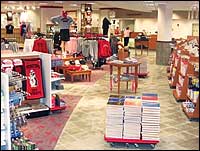
“How you make your increase is through impulse sales,” Lopez said referring to the overall bottom line. “Once they pick up the merchandise, you've got them [customers] 85 percent hooked.” The more flexibility built into a store through the use of fixtures on carts and wheels, the simpler it is to vary the layout, expand and contract departments, or move merchandise onto or off of the sales floor, Lopez explained.
THE COLLEGE STORE OPENS ITS DOOR TO CAMPUS AND COMMUNITY
The College Store is in a unique position as it contributes financially and stokes school spirit for Hobart William and Smith Colleges, two distinct institutions that share academic and administrative services. Hobart is a men's college founded in 1822 and William Smith College was founded in 1908 for women. The combined population is about 1,800 to 2,000 students. Not only does the bookstore enjoy a good relationship with the campus, but with the nearby community and greater Geneva, N.Y., too. “We have a street presence, dedicated parking, and a growing community customer base,” said Lucille Smart, director of The College Store. “We are one of a few bookstores in the area, and proudly feature a general book department with 15,000-plus titles. We have one of the best children's and local-Interest departments in the area.” This August, the College Store expects to debut a revised Web site with a wider merchandise assortment. “We receive daily e-mails and phone calls asking about merchandise not represented on our current Web site,” Smart said. “We expect customer satisfaction and sales of school spirit merchandise to increase significantly when our new Web site goes live.”
The College Store regularly hosts or sponsors various “special events” to build relationships with students, staff, faculty, as well as Geneva and the surrounding communities. Book Browsers Luncheon is a free, one-day event held early each December to coincide with holiday shopping and is open to everyone on campus as well as the public. In its 15th year, Book Browsers includes a catered lunch and 20 percent off pricing storewide all day, which, Smart said, results in sales three to four times higher than average daily revenue. Children's Books for Holiday Donations, in conjunction with Book Browsers, is where The College Store solicits donations of books for area children for holiday gift giving. “We select a nonprofit agency that serves children, decorate a tree with information regarding the agency and its services, indicate the age of the children served, and invite our customers and colleagues to buy one of our children's books or bring one from another source and donate it to the worthy cause,” Smart explained. Free Coffee Friday and Friday Specials is where The College Store features various Green Mountain coffees each Friday during the academic year while discounting general books, clothing and supplies, usually by 20 percent, on one item or across a line. 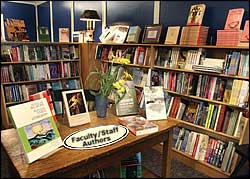
Book and Craft Fair is an annual, one-day event held on the Sunday prior to Thanksgiving in the Bristol Field House, which is two or three blocks from the store. It features local authors and arts and crafts by Hobart William and Smith students, staff, local art guilds, as well as individual artists and crafters from surrounding communities. Senior Appreciation. Once a year, The College Store distributes certificates/coupons to seniors one week prior to semester's end, which are good for 20 percent off. Tours/Story Time is for area schools and preschool/daycare organizations and include complimentary beverages, cookies, free gifts, coupons for future savings and a story, if requested.
BOOKSTORES SET UNIQUE PATHS TO SUCCESS WITH INSIGNIA MERCHANDISE
Commencement, class reunions and, of course, starting the academic term every fall all mark distinct peaks in the annual college store business cycle and points at which different segments of inventory contribute to a better bottom line.
New York University this year introduced academic insignia merchandise that identifies schools of study within the institution plus a line tied to athletic programs, whether it has active teams or not. School spirit items sell consistently throughout the year, but segments within the category get a boost at Skidmore College and Westmont College from the timing of campus events, such as student orientation, graduation and class reunions, in addition to sports activities. Stores need to look ahead and prepare for events to make the most from potential sales. As commencement and class reunions approach, stores want to be ready with children's lines for parents and alumni visiting the campus. Seasonal changes, meanwhile, transition sales from jackets in the fall to T-shirts in the spring.  HOBART WILLIAM AND SMITH COLLEGES HOBART WILLIAM AND SMITH COLLEGESInsignia merchandise is essential to The College Store at Hobart William and Smith Colleges contributing financially as well as stoking school spirit for a student population of 1,800 to 2,000. “Our store reflects the mission and purpose of the colleges, but also needs to be fiscally responsible,” said Lucille Smart, director of The College Store at Hobart William and Smith Colleges. 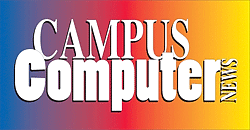
TECH BRIEFS:
IPOD POWER
Belkin has four power accessories that will charge, sync and/or plan on an iPod. At home the Power Dock ($34.99) charges, syncs and plays an iPod through a computer while the Power Dock AV ($49.99) charges, syncs and plays an iPod through a home entertainment center. The power adapter ($24.99) connects an iPod directly to a wall outlet and a USB cable for charging. Charging Kit for iPod ($34.99) includes wall outlet and in-car power adapters plus a USB cable for charging. MACBOOKS AND MOREApple updated the MacBook Pro line of notebooks with the latest Intel Core 2 Duo processors plus memory up to 4GB and high-speed graphics in a lightweight aluminum body that is just 1-inch thick. MacBooks come with a 15- or 17-inch display, the latter with a high-resolution option. All models include a built-in iSight video camera, MagSafe power adapter and built-in 802.11n wireless networking. Prices start at $1,999. A near final version of Mac OSX Leopard was unveiled in June. Scheduled to ship in October, Leopard is expected to introduce over 300 new features, including a new Desktop and Dock with Stacks, an intuitive way to organize files; an updated Finder with Cover Flow and a way to easily browse and share files between multiple Macs; Quick Look, a way to rapidly preview most files without opening an application; Time Machine, an easy and automatic way to back up and restore lost files or a complete Mac; Spaces, a way to create groups of applications and instantly switch between them; and enhanced iChat and Mail applications. Leopard also includes technologies to take full advantage of the latest developments in processor hardware: full native 64-bit support to enable applications to take complete advantage of 64-bit processing while running side-by-side with existing 32-bit Mac OS X applications and drivers; easy multi-core optimization and scheduling to take advantage of the latest Intel hardware; and Core Animation, for developers to create animated user experiences. Suggested retail price is $129. Apple also introduced in June, Safari 3, a Web browser for Windows PCs and Macs. The free public beta version is available immediately as a download at www.apple.com/safari. The final version will be available as a feature in the upcoming Mac OS X version 10.5 Leopard and as a free download to Mac OS X Tiger and Windows users in October. GATEWAY NOTEBOOKSGateway's two new notebook personal computers feature the Intel Centrino Duo processor and combine professional features, such as widescreen displays, enhanced security, leading graphics and more than 10 1/2 hours of battery life. The E-475M is a desktop replacement with a 15.4-inch widescreen display. The E-265M is a lightweight notebook with a 14.1-inch screen. Prices start at $1,299. NEWS & FEATURES:
FORRESTER STUDY CONTAINS CUSTOMER SERVICE CLUES FOR COLLEGE STORE
A recent examination by Forrester Research into how well four national retailers help customers to select a digital camera revealed clues college store stores can apply to enhance the experience of shopping for consumer electronics as well as other categories.
“The In-Store Experience: Selecting a Digital Camera,” Forrester examined the in-store experience for researching and selecting a digital camera at four well-known, national retailers: Best Buy, Circuit City, RadioShack and Wal-Mart. The outlets studied were in Massachusetts. The first step is Wayfinding. A customer's experience begins upon entering the store. Finding the right location requires clear signs and an unencumbered pathway to the desired department. Forrester evaluated whether signs directing customers to a department are clear and legible from key locations, are coordinated and if the pathway to get there is plain. Second is Browsing. Once in the correct department, customers need to examine the different options available. Forrester evaluated how logically organized merchandise was and the content available to help users narrow down the options. At this stage, customers not only need to easy see all of the merchandise, but find it grouped in a way that supports the decision process, such as room to interact with it, supporting category content and clear, easy-to-read signs. Third is Studying. Customers often need more than just high-level information about items. The in-store experience should support any required physical interaction with the merchandise as well as provide all the necessary content for the customer make a decision. For this aspect of the customer experience, Forrester evaluated merchandise accessibility, how easy it is to read merchandise information, is the language clear, is the information presented consistently across the choices, and is the information complete. Fourth is Help. After all the self-help assistance stores provide, a customer may need additional information about merchandise or advice regarding comparisons. In this case, customers should be able to easily find a helpful employee or get access to alternative channels that aid decision making. In this category, store employees were evaluated for accessibility, support to assist customers with the decision process, is research easily continued at home and are any kiosks or other additional decision-support resources accessible.
Cover photo and other Hobart and William and Smith Colleges pictured courtesy of Kevin Colton, HWS photographer. |
|
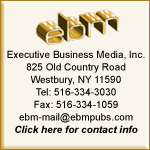 |
Click on a title to link to
an EBM publication: |
Contact Information Subscribe Archives EBM HOME